#Global symbiosis
Text

A Glimpse into Symbiosis University's Global Marketing Perspective
This image provides an insight into Symbiosis University's Distance education strategies and perspectives on global marketing, highlighting their initiatives and programs designed to engage with international markets.
0 notes
Text
It's [the] 21st century. It's a global world we are living [in], and we just ignore other people's lives. How come?
- Arif Jebtik in The True Cost - The Truth of the Clothing Industry
#q#quotes#arif jebtik#the true cost#mindful consumption#mindful living#mindfulness#fashion industry#fast fashion#textile industry#ethical consumption#globalization#industrialization#symbiosis#earth stewardship#holistic leveling up#leveling up#that girl#green juice girl#holistic healing#sidewalkchemistry
0 notes
Text
Australian Pokemon - new evolutions
Another set of my Fakemon designed for my original Goorda Region based on a combination of Australia and Aotearoa/New Zealand. This time I'm designing new evolutions for older Pokemon, plus a bonus convergent line. Links to previous entries below.

Factortry, the Industry Pokemon, fire/steel type, an evolution of Torkoal. It started eating metal as well as coal and its internal heat melted the metal into slag. The slag has started covering its shell, increasing its defense, but the smoke it releases is toxic. During the industrial revolution, Factortry were used for metal refining, but the practice was banned after it produced too much pollution.
Factortry is based on a coal-burning refinery and industrial age factories, with all the pollution that came with them. Industrial pollution has been reduced thanks to regulations, such as the ones that banned Factortry for use in refining. Its name comes from "factory" and "tortoise".

Castla, the Coral Pokemon, water/rock type, an evolution of Corsola. Its branches have grown together into a fortress-like structure that is virtually unbreakable. It has a symbiotic relationship with small Pokemon that live in its fortress. It defends them from predators while they help clean it. It needs clean water to live in and the populations has dropped considerably due to pollution.
I figured that if Galarian Corsola gets an evolution, the original should too. Like the original, this Castla is based on staghorn coral, but also castles. A castle is a type of barrier and Australia famously has the great barrier reef. Reefs are famous as habitats and are essentially ecosystems based on symbiosis, just like Castla. Like the great barriier reef, pollution and global warming is signaling hard times ahead for poor Castela. Its name comes from "Corsola" and "Castle"

Glideon, the Sugar Glider Pokemon, flying type, an evolution of Eevee. Glideon live in trees and glide around their rainforest homes on flaps of skin between their legs. Using their tails as rudders, Glideon are very proficient gliders and they will perform aerial tricks to impress each other and attract mates. Trainers should be aware that Glideon are highly social and need a diet high in sugar.

Wormeon, the Velvet Worm Pokemon, Bug type, an evolution of Eevee. Wormeon are reclusive beings that live deep in the forest and are rarely seen. Their fuzzy pelt is so soft people can get addicted to petting them. Wormeon bodies are soft and fragile, so they defend themselves by spitting out sticky slime and powerful acid.
If Gamefreak won't make new Eeveeloutions then dammit I will. Glideon is based on sugar gliders and Wormeon is based on velvet worms. Sugar gliders are a type of possum that glide around on skin flaps called patagia and have a very fruit-heavy diet. They are found in Australia and have been exported as exotic pets. Unfortunately, the biggest provider of sugar gliders is pretty unethical. Velvet worms are members of a unique phylum and can be described as worms with legs. They are very soft, hence the name, and spit slime for offense and defense like Wormeon. There are many species of velvet worm in Aotearoa. I may end up revising the Wormeon design as I'm not totally sold on it. I don't think it looks enough like an Eevee for my liking.

Frozosis, the Cryptobiosis Pokemon, ice type. It was once thought to be a regional variant of Solosis, but is now known to be unrelated. These strange Pokemon are found frozen under the ice on high mountains, where the cold keeps them in stasis. Scientists believe they froze themselves possibly millions of years ago to survive a mass extinction and are only now beginning to thaw out. Those who thaw out often roll down the mountains to be found in the lowlands.

Frozosis evolves to Frozuion, the Cryptobiosis Pokemon, ice type. Despite being frozen to the point where biological activity should cease, Frozuion are still capable of moving and feeding. Scientists suspect they are in a sleepwalking-like state of half-stasis and that if one were to fully thaw out, it would have mysterious powers, though nobody knows how to do it safely.

Frozuion evolves to Reunifroz, the Cryptobiosis Pokemon, ice type. They have some strange power that allows them to levitate and act alive, despite being frozen so cold that no conventional life could exist. Scientists are unsure of what would happen if one were to thaw out as they are so cold even molten magma cannot warm them. It is possible that a thawed Reunifroz would have powers unlike any other Pokemon.
The Frozosis line is convergent to the Solosis line. They are based on cryptobiosis, a state of near-death stasis that certain living things can enter to survive extreme conditions. The Solosis line are based on embryo development and the Frozosis line are based on frozen embryos. The first successful pregnancy from a frozen embryo happened in Australia. Because it's frozen and in cryptobiosis, the cell in the Frozosis line doesn't develop like the one in the Solosis line. Frozuion and Reunifroz are based on micro-animals. Some species of micro-animal can enter cryptobiosis to survive changing conditions. Frozuion is based on a tardigrade (the poster child for cryptobiosis) while Reunifroz is based on a rotifer. Their names come from "frozen" and the Solosis line's names.
Previous entries in this series. Misc 4, misc 3, single-stages, non-natives, regional standards, creepy lines, regional variants, birds, early-game standards, misc 2, misc 1, starter variants, starters
#pokemon#fakemon#original pokemon#oc pokemon#australia#aotearoa#new zealand#new pokemon evolutions#torkoal#corsola#eevee#eeveelution#convergent pokemon#tortoise#factory#industrial revolution#coral#coral reef#great barrier reef#sugar glider#velvet worm#cryptobiosis#frozen embryo#tardigrade#rotifer
41 notes
·
View notes
Text
Happy New Year!
Let's imagine it was the Earth itself that was going into its 2024th year. That is to say, we're compressing the entire history of the Earth into just the past 2023 years. What events would have happened when?
Well, not too much is certain about the first couple decades after our planet formed, until around 50 CE when we were hit by another proto-planet, Theia, and the debris formed the Moon. After a couple years of the planet cooling down again, the oceans formed out of boiling rain. The timing of the origin of life is very uncertain, but there are chemical signs it may very well have happened as early as the second century. Around 200 CE, the gas giants did a big funky orbit-swapping dance, and in the process inflicted the Late Heavy Bombardment on the rest of the solar system, meaning the Earth was suffering a ton of meteorite strikes for the entire third century.
The first indisputable evidence of life is from around 330, and the first stromatolites appear around 470. Those are basically the first fossils, stones created by layer upon layer of oxygen-producing cyanobacteria living and dying on top of one another. But even with oxygen producers evolving, it would take many centuries before oxygen became a major part of the atmosphere: not until the Great Oxygenation Event, which happened during the ninth and tenth centuries. That's also about the time the first complex, eukaryotic cells evolved through a symbiosis between an anaerobic archaean and an oxygen-breathing bacterium. The bacterium became more and more focused on just the oxygen-breathing task inside the larger cell, until its descendants were mitochondria, which as you all know are the powerhouse of the cell. The next seven centuries passed by with only slow, gradual changes, and life continuing to be unicellular and difficult to find in the fossil record.

(1735's Snowball Earth, by me)
From 1704 to 1730, the entire planet froze over. After merely two years of thaw, it happened again, this time lasting from 1732 to 1742. But these snowball Earth episodes set the stage for the evolution of animals that began right after. Across the mid-18th century, the bizarre Ediacaran biota, with its strange symmetries, fronds, and fractal-like pattern filled the oceans. In the early 1780s they went extinct, possibly due to a temporary drop in oxygen-levels, only to be replaced by a great variety of quite different creatures in the Cambrian Explosion.
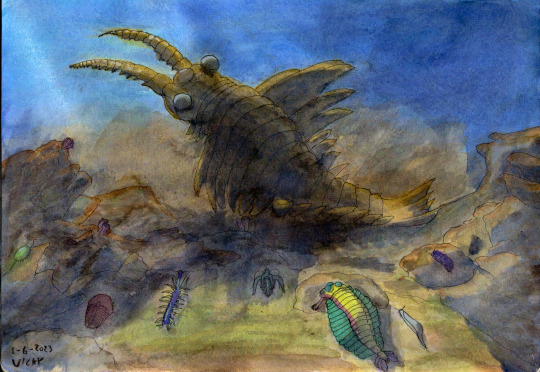
(Class of 1799, by me)
Starting in 1784 and running for a few decades, the Cambrian period saw the origin of most of the modern animal phyla, reaching its most famous form in the Burgess Shale fauna of 1799. During this time, most animals still lived on the sea floor, either attached or crawling, with relatively few actually swimming creatures. Plants started tentatively moving onto land around 1817, and in 1825, the rising of the great Appalachian mountains caused a severe drop in global CO2 and thus temperatures, leading to the Late Ordovician mass extinction.

(Horseshoe crabs and sea scorpions on a beach in 1834, by me)
Bony fish first showed up during the 1830s, and around the same time plants were getting serious about inhabiting the land, evolving roots and vascular tissues so they could properly grow there. Millipedes and the ancestors of spiders were the first animals to follow them onto land. Our own fishy ancestors did not take their first step until 1857, by which point the arthropods were well established there and the plants had figured out how to become trees. The Late Devonian extinction, partially caused by the evolution of said trees and partially by the south pole freezing, played out in two pulses over the late 1850s and early 1860s.
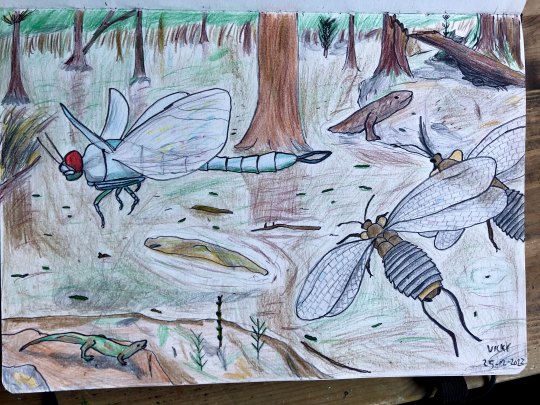
(Swamp prominently featuring Meganeura and Mazothairos in 1889, by me)
Arthropods and vertebrates continued to gain adaptations to life on land. The insects became the first creatures ever to fly in 1878, and the high-oxygen atmosphere of the time would be especially good to them. Around 1884, a group of vertebrates called the amniotes, after the membrane that kept water inside their eggs so they could lay them on land without them drying out, split into two groups: the reptiles and the synapsids (which we mammals descend from). The next few decades would see the synapsids in particular being extremely successful as the supercontinent Pangaea formed. Until 1912, when a massive episode of volcanism caused the worst mass extinction of all time, the Great Dying, scouring the Earth of a huge portion of its life.
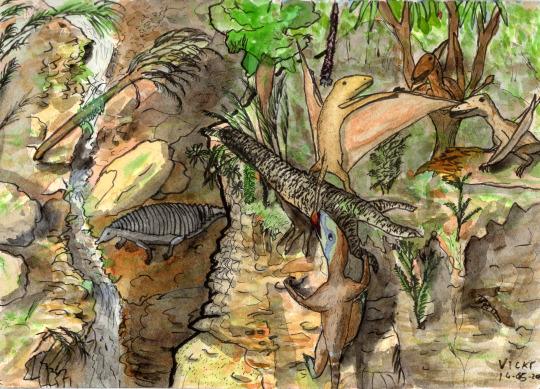
(A 1930 scene featuring the three branches of archosaur: dinosaur, pterosaur, and pseudosuchian, by me)
The 1910s were a period of slow recovery during which strange new forms of animal evolved. Many different, unrelated reptiles, such as the ichtyosaurs and plesiosaurs, went to sea, where they would continue to provide some of the most impressive creatures for most of the 20th century. On land, the dinosaurs first appeared in 1920, though for the next decade or so they'd live in the shadow of their pseudosuchian (crocodile-line) cousins. In 1934, Pangaea began to break up, resulting in another terrible pulse of volcanism that caused a lot of extinctions and left particularly the feathered and furry survivors with a lot of empty niches to fill, allowing the dinosaurs and mammals to diversify greatly. The last common ancestor of all modern mammals lived in the early 1940s, and by 1957 the dinosaurs had figured out flight, with Archaeopteryx usually being considered the first bird. Other dinosaurs took on an incredible variety of sizes, shapes, and forms. Some of the most famous ones include Dilophosaurus (1942), Diplodocus and Stegosaurus (1955), Iguanodon (1969), Velociraptor (1991), and Tyrannosaurus rex (1994).

(A tropical lakeside in the year 2000, by me)
In 1995, the world was struck by a meteorite, wiping out many groups, including the marine reptiles, pterosaurs, and ammonites. The surviving mammals and dinosaurs went on to diversify across the next couple of years and had formed thriving new ecosystems in the tropical world of the turn of the millennium. The first known bat lived in 2001, and the whales returned to the oceans next year. Around 2009, the world's climates turned colder and dryer. Antarctica froze over and grasslands spread widely. Our last common ancestor with the chimpanzees and bonobos lived in 2021, and by new year 2023, our ancestors were getting brainier and more proficient with tools. That's also when the north pole froze and the Quaternary ice age cycle began. The first known members of Homo sapiens lived on 10 November 2023. The latest ice age started on 14 December, and ended at 2 AM on 30 December. The great pyramid of Giza was built at 6 AM on 31 December and On The Origin Of Species was published at 23:22 PM.
#palaeoblr#happy new year#2024#geologic timescale#vicky's vritings#one year is 2.244 million years if you're curious#and yes i did exclude both year 0 and 2024#since 0 doesn't exist and 2024 hasn't happened yet#my art#i rather enjoy having an extensive collection of my art to illustrate my paleorambles nowadays#incidentally the big bang occurred in 4121 bce at this scale#which is curiously close to the date of creation creationists made up#if only they would follow through and insist humanity itself was seven weeks old too
124 notes
·
View notes
Note
i was wondering if you could give some general tips for is3?
i have a decently developed account but i still cant manage to even get to the first boss every run, let alone beat it. like most runs in is2 i could at least beat Lucian but here i feel like im hitting a brick wall
I've prepared something special for this ask today.
We will be doing a full breakdown of a squad I've run with restrictions. It's a run I just completed as I'm typing this, so I can go over my thought process on both team building and path taking. I also won a run on my first try with the restrictions in place (in fact my IS3 winrate is actually much higher than my IS2 winrate at this point), so I'm fairly confident my strategies are sound. If the massive text scares you, don't worry. I'll also make a TL;DR version at the bottom.
My Three Restrictions:
Ch'en the Holungday, Gavial the Invincible, Mlynar, Kal'tsit, Texas the Omertosa, Pozyomka, Horn, Ling, Goldenglow, and Yato x Kirin are banned - This is a combination of both CN's usual ban list for IS3 competitions, as well as the latest ban list on Lungmen Dragon's latest IS3 competition for Global. This is to show that I don't need meta ops to win that proper teambuilding is what wins runs
Must be Wave 5 - This means the difficulty is low enough to still be considered "low level IS3", but high enough to have the +1 hope cost, +10 RES, and +15% ATK and DEF on all bosses
CANNOT pick People-Oriented Squad - This means I've got to deal with the big hope costs.
And here is my results screen

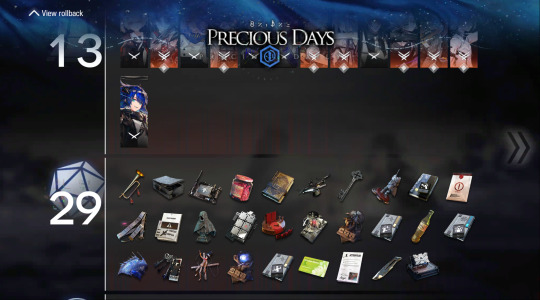

Now I know what you're thinking. "What the fuck Shutters, your run got the -2 hope costs for 4 stars, AND for 5 stars, AND the 6 stars! Carried by RNG!" While it is fucking hilarious I got all three Hope cost reduction relics when I was trying to starve myself of hope, be assured I didn't get 6 stars - 2 Hope until late Floor 4 where it was hardly relevant. i'd actually rather have gotten combat relics since I still had Hope leftover by the ending.
Let's get into teambuilding and decision-making.
I started this run with 8 Hope (got the pre-run bonus for +2 starting Hope), which let me recruit one 6 star at the very start (I always go with As You Wish so I can get a 4 star for free). In this case, the random shuffle I got was a 4 star Defender voucher, a Vanguard voucher, and a supporter voucher. My starting squad was Gummy, Ines, and Orchid.
In both IS2 and IS3, a usual strategy is to have one core 6 star operator carry you through the early game until you grab more vouchers. Ines is an incredible starting core in this difficulty, since she sees through Invis, is a fast redeploy, is a vanguard, can block enemies, and has enough damage in S2 to get you through Symbiosis in the worst case scenario. I'm actually surprised she isn't considered ban-worthy.
Your biggest threats in the first two floors are Symbiosis, Sniper Squad (if emergency), and Malady. Always, ALWAYS try to have one operator capable of blocking enemies on the ground. If you get all ranged vouchers, bring someone with a summon such as Beeswax if Caster (or Amiya then change to Guard Amiya), an Artificer for Supporters, or Totter (to kill invis) or Rosmontis for Snipers. If you get Emergency Sniper Squad and have no way of blocking or killing invisible units, you autolose. Malady wants you to have either two melee blockers, or one melee with a medic and some ranged damage. Symbiosis is the biggest threat — One unit has to be able to block, and you need strong DPS to cut through the horde. There's no shame in losing to Symbiosis, you either got the operators you need, or you autolose, so I always make a starting team assuming I'm gonna get Symbiosis.
I got lucky with a medic voucher and got Pith (who is so damn good), and on my next defender voucher I got Spot instead of upgrading Gummy. This is because I wanted to get two sources of melee block-3 ASAP since I was lacking in AOE, and Spot is one of the best 3 stars in IS thanks to being Block-3, tanky, having a heal, and evasion. He's worth the 1 hope.
Once you get ground units and a heal, hopefully by Floor 2, you want to start preparing for Floors 3-5. In this case, I got a Sniper voucher and immediately got Kroos the Keen Glint. I consider Kroos the strongest Sniper in IS3 just behind Pozy herself, because she has two traits any IS3 team needs: a source of stun/bind/freeze, and strong anti-air. The Stun/Bind/Freeze counters two gimmick enemies, UFOs (I forgot their real names but you know which ones) and the hated Nethersea Predators from Stulifera Navis. Both enemy types get countered by crowd control.
So by early Floor 3, I had Ines (promoted), Kroos the Keen Glint, Pith (promoted), Spot, and Gummy. At that point I had pretty much everything I needed to make a run to Floor 5 (to reiterate: one fast redeploy, several ground operators, good anti-air, at least one source of stun that can also hit air units), so I began grabbing operators that synergized with my collectibles. Hand of Pulverization meant Rosmontis, uh, pulverized everything, Gnosis was a second source of crowd control in case I got unlucky with Kroos' stun crit RNG (protip: In IS, getting two different kinds of operators who have overlapping roles will carry you deeper into runs since it gives you leeway to make mistakes), and I got Firewatch for that mix of AOE burst damage, invis if need be, and for her incredibly high damage against ranged enemies.
I got two cursed relics on the way. - light per battle, and all operators start with -15 SP. I always try to pick a path with Fortuitous Opportunity since you can trade cursed relics for good ones. Luckily, I had two such nodes, one in Floor 3 and one in Floor 4.
If operators get cursed (which can indeed be instant losses if it's a bad curse very early on and on your core operator), I go for the node that lets you send units out for supplies, it removes curses and promotes operators. At Wave 5 or below you always start with 100 Light, so it's possible to avoid instant loss curses by playing well in Floors 1-2 and not losing any lives (so even if you roll a 1 you don't get cursed)
While you can start freestyling team building once you have your important roles all assembled, I personally like grabbing counters to Floor 4/5 stages that have the biggest chances of ending my run. For this run in particular, these are
Lin, for Out of Control - This stage is one of the most terrifying no matter how experienced in IS3 you are, simply from the sheer amount of Possessed and Bonethrowers coming at you. Lin hard counters this, since with her module active, Bonethrowers cannot break her shield, giving you a tank that doesn't need medics.
Franka for Ubi Bona Somnia - Those spear-zombies from originium dust have 2000 DEF and 80 RES (90 at Wave 5), Franka is there to kill the one that spawns in this stage specifically.
Pompeii (Territorial Tendencies) - I didn't need to grab a counter for in case I met Pompeii since I already had Firewatch and a hand-powered Rosmontis, but if I didn't, it's always a good idea to grab an anti-Pompeii unit like Jaye.
Then once I got to Highmore it was a simple matter of knocking down Highmore with Gnosis' freeze, pulverizing Phase 1 with Rosmontis S3, knocking down Highmore again with Gnosis, then killing Phase 2 with Ines. If you're aiming for Last Knight or Ishar-mla, your team needs will be different of course!
So! I hope that helped you understand how to think about approaching an IS3 run, but in case none of that made any sense and I wasted 3 hours writing this, here's a TL;DR
What do I generally need?
Floor 1
Ground units because you need to block
DPS to counter Symbiosis specifically
Heals
Floors 2-3
Strong Anti-air (IS3 has a lot of flying enemies)
One fast redeploy like Agent Vanguards or Executor Specialists (effective in a vast majority of stages in IS3)
At least one source of Stun/Bind/Freeze that can hit aerial units (to deal with UFOs and Highmore that need to be knocked down, Nethersea Predators so they stop fucking dodging)
You may realize that Texas the Omertosa has all 3 of these qualities. This is why she's considered an automatic ban in all IS3 tournaments
Floors 4-5
Specific counters to the stages that kick your ass the most
Specific boss counters if necessary
Specific operator combos with your collectibles (for example Cutter + Any spinach type collectible)
92 notes
·
View notes
Text
Race is on to produce a super-coral to survive world’s warming seas
Excerpt:
[....]
Coral reefs are the most spectacular manifestations of symbiosis – and understanding the mechanics of this mutual endeavour has become an urgent task as global warming has triggered the widespread collapse of reefs across the planet.
In a bid to halt this destruction, an international group of researchers led by the Wellcome Sanger Institute is working together on the Aquatic Symbiosis Genomics (ASG) project. Powerful DNA sequencers are now unravelling the genetic secrets of coral, data that could be vital in saving the world’s reefs, and understanding the mysterious processes that drive symbiosis.
“Coral reefs are called the rainforests of the seas for a good reason,” said Michael Sweet, of the University of Derby, and leader of the project. “They provide homes for a vast array of sealife and have an estimated global worth of around £6tn a year because of the fishing, tourism industries and coastal protection they support.”
Read more.
24 notes
·
View notes
Text

Self-sufficient organic Finnish farm grows its own fuel and a greener future
An award-winning farm has teamed up with Helsinki University to create a symbiotic food production system that is self-sufficient in energy and nutrients. It’s a trailblazer in sustainable agriculture.
Photo above: Farmer Markus Eerola shows visitors the biogas plant that helps make his farm an energy producer rather than an energy consumer.Photo: Wif Stenger
Organic Knehtilä Farm provides its own nutrients and energy, thanks to careful long-term planning and a small onsite biogas plant operated by energy utility Nivos.
The biogas powers his tractor, pickup truck and cars, and is available to others at a commercial filling station on the edge of the farm, although vehicles that can use biogas are still relatively rare. It offers a valuable alternative to meet the growing need for affordable, clean domestic energy.
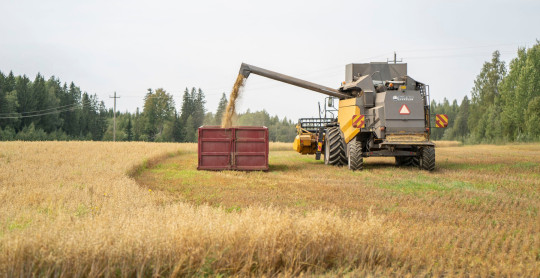
Demand for organic food continues to grow. “The price gap between organic and standard production is narrowing, partly because we don’t need fertiliser. Our farm has its own product line of oat and buckwheat products, which are produced here using a proven cultivation method known as agroecological symbiosis, where nutrients and energy are efficiently recycled.”
The sprawling 380-hectare farm’s carefully balanced circular economy has developed over a decade and a half, earning a WWF award in 2015 as a model of nature-friendly agriculture. In 2021, the Finnish Organic Association chose Knehtilä for the honour of Organic Business of the Year.
“Biogas production can convert farms from being energy consumers to energy producers, and play an important role in the transition away from fossil fuels. When it’s done in a smart way, it’s also possible to increase biodiversity in farming systems.”
Knehtilä forms part of the Global Network of Lighthouse Farms, a project led by Wageningen University in the Netherlands, involving commercially viable farms that offer “radical solutions to address sustainability challenges.” International visitors frequently come to Knehtilä to learn about unique system.
The rich, vibrant cycle of life at Knehtilä is visible in not only the lush fields, but also in the insects and frogs that frequent them, and in a few animals such as horses, sheep, goats, chickens and rabbits. The farm is also a lively event venue; a high-ceilinged, 80-year-old barn has been converted to a space for up to 100 people for weddings, theatre performances and concerts.
#solarpunk#solar punk#indigenous knowledge#reculture#self reliant farming#agroecology#biogas#finland#organic farming#design
34 notes
·
View notes
Text
Broadcast from satellite primordial:
Hello! As you may of guessed, the world is no longer ending, currently my team has begun participating in clean up operations globally, and we no longer recommend avoiding water. The elder god which caused this event has been stopped, but the perpetrators of this, the syndicate, have alluded authorities.
@f4y3w00d5 @monsterfucker-research-wizard @gobodegoblin @blooper-malte @symbiosis-enjoyer
27 notes
·
View notes
Text
Western Godzilla inspired fan continuity : a different kaiju faction
Now, Godzilla Unleased introduced the idea of formalized kaiju "factions"
Earth Defenders: An alliance of Godzilla and Mothra's allies and acquaintances.
Global Defense force: The human controlled mechs and Jet Jaguar
Aliens: Work for alien invaders
Mutants: Power hungry or distrustful. They just distrust eachother less than they do the other factions and are impressed by power. A temporary alliance if anything.
And quite a few DeviantArt artists liked that, it was fun. However what works for a global spanning apocalyptic event might not work with all tone/setting/ plot ideas
"Mutants" (a terrible name really, when their unifying ethos has nothing to do with origin), was interesting because it had no real prior basis in the franchise unlike the other.
However, there is a faction idea I have not seen much of
A horde/swarm

Generally Aesthetic: Creepy crawlies turned giants: arachnids, lizards, insects.
Examples of precursors to this can be found by the adoptive family of Desert Monsters that escaped from a lab (plus Varan) in Scott Ciencin's Godzilla Invades America and Godzilla: Journey to Monster Island; the Kamacuras swarm in the Godzilla 2000 novel by Marc Cerasini; and the Area 51 episode of Godzilla the Series that showed some mutants peacefully cohabitating in their enclosures.
Building mainly on the first, this is a new type of faction of kaiju: a full on migratory community that builds temporary nests, where adult members that don't pull their weight face expulsion (like the prank-loving scorpion monster Sasori in Godzilla Invades America, who was not interested in capturing humans to feed to the younger monsters in the nest)
The membership is fluid, taking in new members and ejecting those that refuse to share food.
Beginning with escaped experiments, other kaiju of different origins (prehistoric, atomic mutations, or experiments in different locations or by other people) could join them in their travels.
Why such different species are capable of working together may lie in the exact nature of the classified experiments (attempts to make a kaiju army capable of working together most likely). [It did not get explained in children's book where Ant-man style size-changing technology was the main plot device]
Kamacuras
Kamacuras and Kumonga, a giant mantis and spider from the Godzilla films, were the founders of the horde of giant desert creatures in Scott Ciencin's books.
Multiple Kamacuras were shown as cooperative hunters in their first appearance on film, and instead having them just be prey Kumonga, both Scott Ciencin and Jacqueline Dwyer (writer of the children's picture book Godzilla on Monster Island) teamed the spider and mantis up.
Scott's books even had Kamacuras carry Kumonga while flying.
(Scott Ciencin also made Kamacuras a brawler like an actual mantis rather than cannon fodder, taking on Godzilla in single combat and less flammable.)
Random thoughts for Kamacuras
(I've proposed in the past a warped symbiosis where Kamacurus are brood parasites of Kumonga and feeding on its eggs, making them mantis flies rather than mandtids, )
If want to get warped, you could have a leader Kamacuras feeding other Kamacuras that fail to dethrone them to Kumongal or threatening to only to pull them back at last moment
Kamacuras dipping its claws in the venoms and poisons of allies could be an interesting way to make them a greater threat
Hana-Barbera Godzilla
The Valley of the Giants episode has some examples of other giant insects
Godzilla the Series
Many creatures from Tristar's Godzilla the Series could be repurposed for such a faction, such as the
giant rats,
The Giant Widow spiders brood,
the giant water beetle,
Giant Bees and Giant termites, and their queens
Batty the giant bat (even works with how many of the original monsters in Godzilla: Journey to Monster Island have cutesy names)
the area 51 monsters: the giant armadillo, and thorny devil
From Godzilla: King of the Monsters by Marvel:
I could see Doctor Demonicus' creations having the proper aesthetics for a horde of monsters. While in the book they could not leave the lair for long without dying from lacking a special form radiation they depended on, that can easily be dropped.
Ghilaron: giant lizard. has a saillike fin like a bassilisk lizard, and a backward curving large horn that brings to mind parasauralophus
Centipor: Giant wormlike thing with many legs that look soft and rubbery like a toy. ( I think looks more like a deep sea woerm of some kind. Has many antenna and what may be feelers or prooboscids a random-seeming pattern on head. Has a very different design on the cover of their comic.
Lepirax: Butterfly inspired monster with jaws instead of a proboscis. An agile flier that goes after smaller targets such as helicopters in their comic appearance, mostly ignoring Godzilla at first. Could be combined design-wise with Dark Horse's concept art for an unuse Mothra-like monster for their Godzilla comic series. The scary American posters for Mothra (1961) could also be an inspiration for a design.


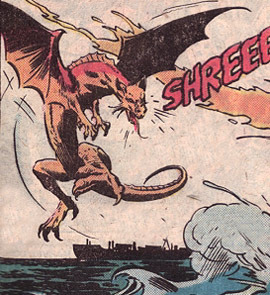
Batragon, the most powerful of Demonicus' creations, a combination of bat and Komodo dragon, (and smart enough it could be trained to immobilize ships without destroying cargo) could also fit if they lose a master commanding them and go rogue.
Related monster idea
Ts-eh-GO
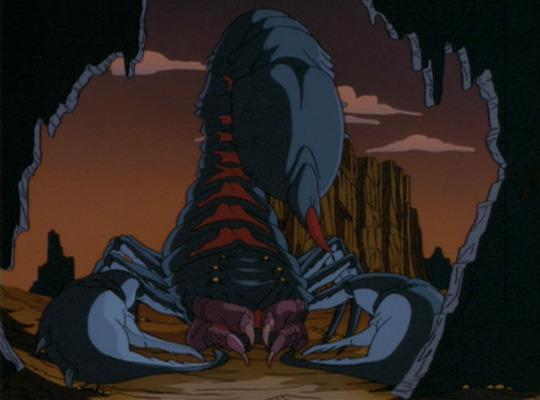
A trained giant scorpion under the employ the U.S army, the plot dumbly has the army betray and try to kill it after a cheaper bioweapon of a swarm of smaller scorpions is developed.
But honestly in a more continuity driven story , a human government having a kaiju under their control with mixed feelings about and could be tied to the mystery and intended goal of the labs of members of a swarm mentioned above. Ts-eh-go (who needs a slightly different name as it's just the Navajo word for scorpion enunciated slowly) could be their only success.
Ts-eh-go in their episode seems to cause psychic disturbances with one character having prophetic nightmares about it. While just a weird plot point , it could be turned into a thing where the creature just gives "bad vibes" to psychically sensitive as a side effect of experiments. Like the opposite of Mothra.
#godzilla#kaiju factions#ts-e-goh-#godzilla the series#long post#godzilla fan timeline#brainstorming#godzilla au#godzilla marvel series
20 notes
·
View notes
Text

It all starts with a story. That’s the premise behind elk & HAMMER, an online gallery featuring a global collective of artisans and makers redefining what it is to live and work, finding a symbiosis between the two in a manner both new and very, very old.
elk & HAMMER currently features a growing body of work from sculptors, ceramicists, designers, painters, metalsmiths, and more. Each addition to the gallery represents another story in an ever-evolving tome exalting both the maker and the made. (Sponsor)
See more on Colossal.
55 notes
·
View notes
Text
Mushroom of the day:
Chanterelles/Cantharellus spp.
Geographic location: global; growing location: Mycorrhizal species, andsymbiosis with conifers or hardwood trees
Characteristics: small small and generally orange, orange, yellow trumpet shape, mushroom that has gills running up the sides
Edible
Jack-o’-lantern mushroom is a dangerous look-alike. It is not deadly, but will make you very sick
There are a couple different types, 1. Golden Chanterelle/Girolle-grows in Europe, 2. Cantharellus minor -tiny Chanterelle , first reported in North America, but recently reported in Kerala,india,3. Peach chanterelle /pink chanterelle-grows in the Appalachian area ,4. White chanterelle-White mushroom, but bruises, orange ,5.Cantharellus lilacinus-purple to lilac ,6.  Cantharellus texensis- fiery reddish orange found primarily in Texas, but pops up in Louisiana Mississippi, Alabama and Florida



#nature#cottage aesthetic#mushrooms#fungi#red orange#chanterelle#white#purple#lilac#texas#mississippi#india#follow#fungi aesthetic
4 notes
·
View notes
Text
A Glimpse into Symbiosis University's Global Marketing Perspective
Marketing across cultures is not merely translating slogans but a complex understanding, adaptation, and relating to various audiences. For insights that offer the intricate scope of this field, the name that comes to mind most often is Symbiosis Distance Learning Center, renowned for its global approach.
The Global Marketing Scenario
Globalization has revolutionized the marketing world. Brands…
0 notes
Text
Post Graduate Diploma in Healthcare Informatics & Analytics (PGDHIA) at SIHS
Symbiosis Institute of Health Sciences (SIHS) offers you an opportunity to undergo Post Graduate Diploma in Healthcare Informatics & Analytics (PGDHIA). Healthcare informatics combine skills in healthcare business intelligence, information technology, information systems and data analytics. Doctors, nurses, and other healthcare professionals depend on healthcare informaticians to store, retrieve, and process medical data. With a Post Graduate Diploma in Healthcare Informatics & Analytics (PGDHIA) will equip the students to develop a capability in healthcare informatics and learn the technologies & skills required for the analysis of information regarding various healthcare-related factors. This programme will train the students to apply appropriate techniques to solve problems in different application areas in healthcare informatics. One can become a high-end knowledge worker in the clinical and medical fields, using information technology to help people with their health. This comprehensive program covers multiple aspects of health data informatics, including statistics for data science, augmented & virtual reality, health data analytics and artificial intelligence.
Mode of teaching: Online + Weekend Classes
Career Opportunities:
1. Chief Medical Information Officer
2. Health information Analyst
3. Healthcare IT Project Manager
4. Public Health Data Scientist
5. Health Informatics Consultant
6. Telehealth Coordinator
7. Health Information Manager
8. Electronic Medical Record Keeper
WHY SIHS ?
1. Established reputation in educational excellence.
2. World-class faculty, excellent career guidance.
3. Innovative teaching style – combination of lectures, practical training, discussions, projects, workshops.
4. State-of-the-art infrastructure.
5. Beautiful sprawling campus with excellent libraries, computer labs and Wi-Fi access.
6. Career Counselling, Training & Placement Assistance
7 Truly multicultural, dynamic and globally oriented learning environment
Admission Process -
Step 1: Register online at www.sihs.edu.in and make payment of registration fees (INR 1250/-).
Step 2: Attend Personal Interaction in online mode.
Step 3: Check email for selection confirmation.
Step 4: Verify documents and pay academic fees (INR 89,000/-).
Program Outcome -
1. Learner will be able to manage, process and analyze healthcare data
2. Learner will be able to apply knowledge gained and technical skills in the real-world healthcare settings
3. Learners will comprehend healthcare informatics principles, data analytics methodologies, and the integration of technology within healthcare systems.
4. Learners will explore machine learning, artificial intelligence, and big data analytics, understanding their applications in healthcare.
5. Learners will contribute to enhancing the quality and efficiency of healthcare services.
For more details visit: https://www.sihs.edu.in/pg-diploma-in-healthcare-informatics-and-analytics
2 notes
·
View notes
Note
i'm so curious about what you study at gradschool... what are the papers you are writing now? do you mind sharing? (if it's not something you rather not, of course) (:
Oh, that’s so nice of you to ask? I never think someone is actually interested in what I study… but I’m an IR major and now also in grad school for IR, deep into a more critical/post modern analysis of aesthetics, time, global politics & diplomatic fictions. I don’t have anything substantial to share about the papers, except for the titles…? The first one is an exploration on time, both political but also in the way we perceive/feel/communicate about time & the (linguistical) limitations that comes with it and I’m using an aesthetic symbiosis to built my analysis, through the movie Arrival (2016) & the 1998 tale by Ted Chiang Story of Your Life (Chiang, 2002). The second paper is a “part” of my own dissertation, but it will be an essay on aesthetics & global politics and the use of poetry as a bridge to these concepts.


2 notes
·
View notes
Text
The Everlasting Influence of #MeToo: From Online Hashtag to Real-World Change
Introduction:
Social media movements, the phenomena that are redefining contemporary activism, find their roots not in the digital world but in the lived experiences of individuals. They originate in the offline spaces, the daily lives of ordinary people who are driven by the need to stand up for what is just and right. These movements are deeply entwined with social and political activism and serve as platforms for the disenfranchised and marginalized to have a voice.

However, the trajectory of social media movements, as impactful as they may seem in the digital realm, often faces criticisms of "clicktivism" and "slacktivism." These terms reflect the concern that online participation might lack real-world impact. To truly understand the influence of social media movements, it's essential to recognize the synergy between online and offline spaces, where the most successful movements thrive and endure.
youtube
youtube
The #MeToo Movement: A Case Study:
A prominent example of a social media movement that has transcended both online and offline spaces is the #MeToo movement. It is a testament to the fact that these movements do not begin with hashtags but with the earnest efforts of individuals who strive to bring about change. The #MeToo movement originated in 2006, created by social activist Tarana Burke. Burke's vision was to create a movement that empowers survivors of sexual violence, particularly young women of color in underprivileged communities. She coined the phrase "Me Too" to symbolize empowerment through empathy, laying the foundation for a movement against sexual abuse.
The movement remained largely under the radar for over a decade until 2017, when actress Alyssa Milano shared her personal experience of sexual abuse on Twitter using the hashtag #MeToo. Her call to action resonated with countless others, encouraging them to share their own stories. The hashtag quickly spread across Twitter, being used 1.7 million times in 85 countries. It received support from numerous female celebrities who echoed the message of "Me Too."
The Symbiosis of Online and Offline Spaces:
While the #MeToo movement gained immense traction online and earned recognition as a global digital campaign, its impact was not confined to the digital sphere. It transcended into the physical world, sparking campaigns against sexual violence across various industries, including film, music, politics, education, sports, military, and medicine. The movement prompted legislative and legal actions, such as the Me Too Congress Act, and led to convictions of rapists and sexual abusers, especially those who held positions of significant power in society. One of the most notable outcomes was the conviction and downfall of Harvey Weinstein, a former film producer who had enjoyed a position of authority. The #MeToo movement mobilized diverse groups, including celebrities, activists, survivors of sexual abuse, and everyday citizens. It spanned multiple spaces and platforms, from social media to workplaces, red carpet events, and courtrooms. The movement leveraged social media for awareness, and this digital presence spurred real-world efforts against sexual violence.

Conclusion:
Social media movements are not born with hashtags but with the dedication of individuals determined to champion social justice. The #MeToo movement exemplifies how social media can amplify voices that have been silenced and ignored, providing survivors of sexual violence with the power to share their stories. While hashtags are crucial for mobilizing these movements online, it's essential to acknowledge the pioneering work of activists like Tarana Burke, who laid the groundwork long before hashtags began trending. Social media movements thrive when they bridge the gap between digital and physical spaces, forging lasting change in an increasingly connected world.
The #MeToo movement illustrates that social media movements are more than mere hashtags; they are driven by individuals committed to societal change. This movement, initiated by Tarana Burke in 2006, showcases how real-world impact transcends the digital realm. By sparking campaigns against sexual violence, inspiring legislative changes, and leading to high-profile convictions, it demonstrates the tangible influence of social media movements. Their continued relevance underlines the significance of bridging the gap between online and offline spaces. Social media movements amplify silenced voices and exemplify that true change begins with dedicated individuals.

References:
Hashtag Activism. (2012). Margaret Rouse. Retrieved October 28, 2023, from https://www.techopedia.com/definition/29047/hashtag-activism
Goswami, M. P. (2018). Social media and hashtag activism. ResearchGate. https://www.researchgate.net/publication/326655352_Social_Media_and_Hashtag_Activism,viewed on 28 Oct 2023
alignmedia. (2023, March 16). More than a Hashtag: The #MeToo Movement is 10 years in the Making - ALiGN: Alternative Global Network Media Lab. ALiGN: Alternative Global Network Media Lab. https://carleton.ca/align/2023/more-than-a-hashtag-the-metoo-movement-is-10-years-in-the-making/,viewed on 28 Oct 2023
Burke, T. (2022, October 12). Tarana Burke: What “Me Too” made possible. Time. https://time.com/6221110/tarana-burke-me-too-anniversary/,viewed on 28 Oct 2023.
Jeff Grabmeier. (2023, August 8). Why #MeToo remains a rallying cry for sexual abuse survivors. OHIO STATE NEWS. Retrieved October 28, 2023, from https://news.osu.edu/why-metoo-remains-a-rallying-cry-for-sexual-abuse-survivors/
Rosa, J. (2019, October 16). Alyssa Milano on sharing alleged sexual assault story 25 years later. ABC News. https://abcnews.go.com/Entertainment/alyssa-milano-sharing-alleged-sexual-assault-story-25/story?id=66317784,viewed on 28 Oct 2023
TEDx Talks. (2021, May 1). Can a “Like” change the world? The power of clicktivism | Jenk Oz | TEDxYouth@Engomi [Video]. YouTube. https://www.youtube.com/watch?v=evvv45BAYvc,viewed on 28 Oct 2023
TEDx Talks. (2018, November 12). Slacktivism: Social Media’s Effect on Activism | Sophie Egar | TEDxYouth@PepperPike [Video]. YouTube. https://www.youtube.com/watch?v=dhPIgES_hws,viewed on 28 Oct 2023
Giphy. (n.d.). GIPHY - Be animated. GIPHY. https://giphy.com/,viewed on 28 Oct 2023
6 notes
·
View notes
Text
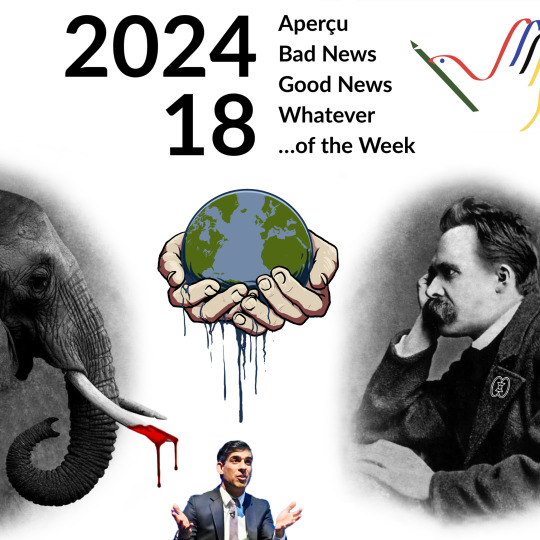
2024 / 18
Aperçu of the Week
"You must be the change you wish to see in the world."
(Mahatma Gandhi)
Bad News of the Week
It was Earth Overshoot Day for Germany. This means that on May 2, we have already used up our national share of global natural resources for the whole of 2024. In other words, we would need three Earths to maintain our current lifestyle. And we are not even the biggest "consumers" - in the USA, for example, Earth Overshoot Day was already on March 14 this year, according to figures from the Global Footprint Network.
So humanity is living off the land. Which, logically, cannot go on for long. What's more, we haven't just been doing this since yesterday and every reserve is limited. This is simply madness. The whole thing has hardly anything to do with climate change, but it all goes back to the same basic problem: "man-made". For the first time in the history of the earth, a species is not adapting to environmental conditions, but wants to adapt them to itself. But nature will not go along with this. It has lost its balance, so the imminent tipping points can be taken quite literally.
It is not yet too late. Humanity just needs to realize that it has to fundamentally change its way of life. From parasitism to symbiosis. A simple and simplified example: humans need oxygen to survive. Which they convert into carbon dioxide. The tree needs carbon dioxide to survive. Which it converts into oxygen. So it works perfectly well in a peaceful coexistence. However, if humans kill the tree by cutting it down, burning it or draining its water, they are depriving themselves of the basis of life. Pretty stupid, actually. And actually pretty easy to understand.
Good News of the Week
Preparations have begun in the UK for the controversial deportations to Rwanda. The police have arrested several people who entered the country illegally. Nationwide operations are underway, according to the Home Office. The first deportation flights are due to take place in July. The relevant law allows the deportation of asylum seekers to the East African country if they have arrived in the UK without permission. The origin of the migrants is irrelevant. The deportations can take place without the asylum applications even being examined in the UK.
Is this supposed to be worthy of a democracy and in line with European values? Certainly not. It is therefore not surprising that the High Court in London has declared the plans unlawful. The judges have doubts that the people in Rwanda will receive a fair asylum procedure. No wonder, because according to Amnesty International, the country has enormous deficits in practically all human rights. And in this ailing state, which is barely larger than Wales, the United Kingdom wants to set up a final dump for asylum seekers. A bad joke.
This joke fits in seamlessly with the Tories' government actions, which since Boris Johnson can only be described as a bad joke in general. They have now been punished for this and more in the local elections. And it is so severe that there is already talk of a "Conservative collapse". And Prime Minister Rishi Sunak may even have to face a vote of no confidence. The loss of half (!) of the seats that the Conservatives had to defend shows crystal clear that the party's shift to the right is not convincing voters either. Nigel Farage's right-wing populist Reform UK is now the real winner in third place.
And the outlook also looks bleak. According to a nationwide survey by the opinion research institute Yougov, only 18% want to vote for Tory in the general election at the beginning of next year. And 44% Labour. The Labour Party, which was significantly realigned by former Prime Minister Tony Blair at the turn of the millennium (catchwords "New Labour", "modern social democracy" and "third way"), have positioned themselves as social democrats with moderation and a middle ground. With Labor, the inhumane Rwanda deal would not have happened. Nor the protection of the rich elite. And no Brexit either. I look forward to the UK showing a human face again soon.
I couldn't care less...
...that Donald Jessica Trump continues to languish in court instead of running a classic election campaign. Even though both actually look the same: he knows everything better, he has never done anything wrong in his life, he is unstoppable, his persecution is politically motivated, unjust and the biggest scandal in history. Give me a break.
It's fine with me...
...that Venice's lagoon Disneyland now charges admission to day tourists when they are already flooding the city. Because when I'm there, I'm firstly an overnight guest who explores the city when the day tourists have gone. And secondly, I'm there for the contemporary art (Biennale di Venezia) and am not queuing in front of the Dojen Palace. And thirdly, the city needs the money to preserve its historical status. After all, if an ice cream parlor sells overpriced bad goods, hardly anything will stick for the community.
As I write this...
...it has come true: there is no longer an "imminent famine" in Gaza. Because, according to UNICEF, the "imminent" must now unfortunately be deleted. And once again, the victims are almost exclusively civilians, more than half of them children. I can't remember the concept of self-defense ever being so strained.
Post Scriptum
Freedom of the press, or rather freedom of the media, is a very valuable asset for me. Because only unhindered access to neutral information can form the basis of a sound opinion. In addition, journalism also assumes a certain control function when it observes carefully, analyzes profoundly and argues logically. It is not for nothing that many call the (reputable) media the "fourth power in the state" alongside the legislative, executive and judicial branches. Therefore, for me, an attack on media freedom is an attack on democracy.
According to Reporters Without Borders on World Press Freedom Day last Friday, 36 countries will be in the category of lowest (or non-existent) press freedom in 2023. There haven't been that many in 10 years, including, unsurprisingly, Eritrea, Syria and Afghanistan. Germany is in 10th place behind the Scandinavian countries, as there were 41 verified attacks on journalists. They tend to be associated with conspiracy theorists and the extreme right. Of course, because after all, they think the least of media freedom.
#thoughts#aperçu#good news#bad news#news of the week#politics#mahatma gandhi#germany#earth#overshoot#environment#humanity#usa#parasitism#uk#rwanda#asylum#democracy#human rights#labour#donald trump#venice#famine#gaza#press#freedom#media#journalism#unicef#elections
3 notes
·
View notes